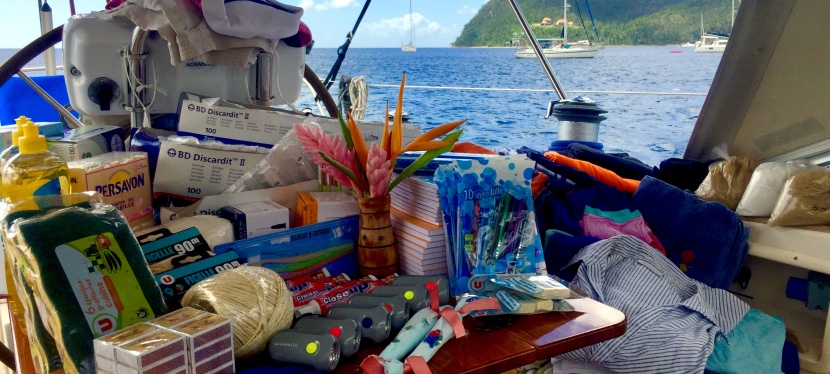In September 2017, our current host country Dominica was badly hit by Maria, one of the worst hurricanes ever. We were still in Portugal at that time and tried to figure out whether our trip into the West Indies was still meaningful. Five month further down the road, we know that it was right to move ahead and especially also great to visit Dominica.
The storm killed the trees and destroyed thousands of private and public houses. Worse, it left thousands of people homeless, insured, or even dead. Who didn’t loose their life often lost everything else, for example also the most basic things as the underwear. There was little money before the storm, and now it’s even less.
Sailors loved Dominica in the past when times were good. So many sailors
somehow feel responsible to be there with help in bad times as well. So do we. In the internet we found lists with what they need most, and so we prepared seven bags full of useful things. But to whome to give it? This was the next thing to find out.
It was Sunday when we first went ashore to get a first impression of the general situation ashore. For our first scouting mission, we left the bags on the boat. We wanted to find
– someone in need of cloth
– three parties in need of basic household things
– a school for all the paper blocks, pens, ball pens, color pens
– a doctor for the medical stuff, mainly 200 syringes and needles
We found the school and a church. We thought that the pastor should know who is in need, but we couldn’t find anyone that time of the day. Next to the church was a big white tent marked UNICEF. We assumed that this was the coordination center for children’s aid. Perfect. As it was Sunday, it was closed as well and we decided to continue our scouting on Monday.
On Monday the tent still had the door rolled down, but some noise came from inside. We found a cleaning lady in there. She explained that the tent was a temporary class room because the school nearby collapsed in the storm. We talked a bit to Simone and learned about her situation. Soon it turned out that we found someone in need of most of our things except the needle stuff. We agreed to deliver some items on the next day.
Simone was 53, actually looking somewhat younger. The youngest one of her ten children had just turned 15. She was also a proud grandma of eight, very friendly, but now homeless on her two acres of land. Simone wore the golden ear rings she wore when the storm hit and told us with a smile that she even can’t buy sugar now. She said everything with a smile. She was particularly interested in clothes and school materials for her kids. So we left her the two sets of summer clothing each of us had taken our of his wardrobe on board. Simone gladly took the household bags as well, including two of the dynamo-lamps we bought in Martinique. She recommended to bring the school bag to the school around the corner.
Entering the empty looking school, at 4.30 p.m. we met a teacher just about to lock an intact school building. She gladly received a big bag of paper blocks, and a lots of pens, color pens, ball pens and some craft materials. She recommended to see the hospital rather than the doctor for the syringes and needles we had in our last bag.
So we walked up the road to the hospital. Why did we have so many syrings on board? They were three boxes of 80 pieces with sizes 2, 5 and 20 Milliliters. Those were the smallest packs we could get at home. There should be a couple of syringes on every boat, and so we had a lot to give away.
This bunch of syringes was actually the last bag we stuffed into the car before leaving our home in Switzerland. It was always clear that we couldn’t use all our medical stuff, but we thought it was better to donate it along the way rather than to keep them in our home. Maria only came later.
At the hospital we found a doctor with a stethoscope around the neck and she was very kindly receiving our last bag. We exchanged some words an when saying good bye, she told us “Please come back!”. We found this a nice way to say to someone that we is welcome, but we preferred not to have reason to see this or another hospital from inside for the rest of our trip.
Just a few steps out of the hospital and on our way back to the jetty, a cute
little girl ran towards our daughter. She laughed all over her face and didn’t want to stop hugging our puzzled girlie. Then she hugged Manuela, me, and finally our boy. Her father nearby explained that his little girl is full of love. What a nice conclusion for our charity mission!







